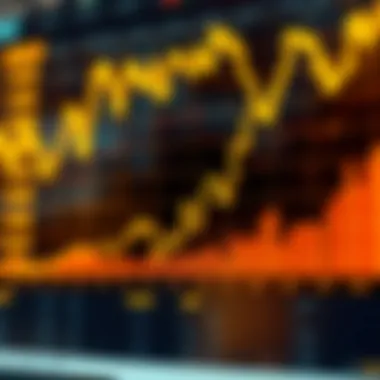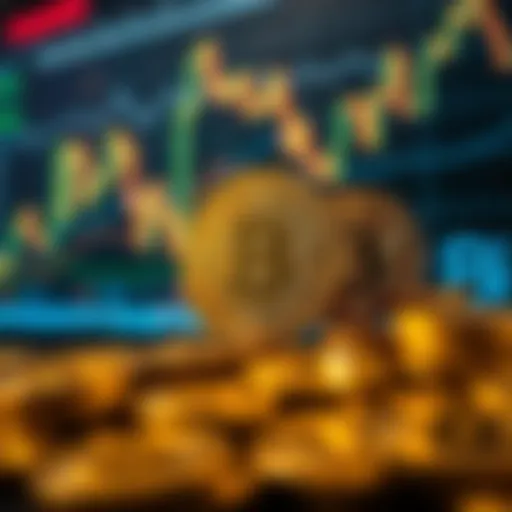Exploring Gold Market Trends and Pricing Insights


Intro
Gold has been treasured throughout the ages, evolving from a mere ornament into a crucial investment tool and a financial safe haven. The gold market is a complex web of various factors that govern price fluctuations, and it’s vital for anyone looking to invest in gold to truly understand this landscape. In this guide, we will dissect the intricacies of the gold market, enlightening readers on the drivers of pricing and the technological advancements that shape financial decisions today.
As we step into this golden terrain, it’s not just about the shiny metal; it’s about grasping the underlying forces that determine its worth. By analyzing trends and investor behaviors, we'll arm ourselves with the knowledge needed to navigate the ups and downs of gold investing, making informed decisions that can shape financial futures.
Key Concepts and Definitions
Understanding the language of gold investment is crucial for success. Here, we will explore key terms and provide a solid foundation upon which to build our investment strategies.
Overview of Investment Terms
When discussing the gold market, several terms frequently pop up:
- Spot Price: This is the current market price at which gold can be purchased or sold for immediate delivery. It’s essentially the “going rate” for gold right now.
- Futures Contracts: Agreements to buy or sell gold at a predetermined price on a specific future date. They're often used by traders who want to hedge or speculate.
- Gold Bullion: Refers to gold in bulk form, typically bars or ingots, and is often considered a tangible asset for investors.
- Market Demand: The quantity of gold buyers are willing to purchase at various price points. It directly impacts gold pricing.
- Central Bank Holdings: Government reserves of gold, which can influence global supply and demand dynamics based on their buying and selling activities.
Significance of Understanding Financial Terminology
Knowing these terms is not just useful; it’s critical for making effective investments. Just as a sailor needs to understand the winds to navigate the seas, investors must know the terminology to steer their financial path. It helps in interpreting market reports, conducting analyses, and communicating effectively with other investors or financial advisors.
"The world is a complex place, but understanding the foundations can simplify many decisions."
Understanding key concepts serves as a stepping stone for anyone looking to take the plunge into gold investment.
Expert Insights and Advice
Investment Strategies for Beginners
For those new to the gold market, a cautious approach often works wonders. Here are a few strategies:
- Start Small: Begin by investing a small portion of your portfolio in gold. This allows you to learn without taking too much risk.
- Diversify: Don’t put all your eggs in one basket. Pair your gold investment with stocks or bonds to reduce risk.
- Utilize ETFs: Gold Exchange-Traded Funds offer an accessible method of investing in gold without needing to physically store it.
Advanced Techniques for Seasoned Investors
For the more experienced investor, sophisticated strategies may involve:
- Trading Options: Using options allows for more flexibility and can provide greater returns if executed correctly, although risk is higher.
- Leveraging Futures Contracts: This can amplify gains, but one must understand the risks involved fully.
- Options on Gold: In this sophisticated play, investors can profit from predicting gold price movements without owning the actual gold.
Prologue to Gold Pricing
Gold has always held an alluring place in human history, and its pricing is a subject that captivates not just investors, but nearly everyone interested in economics and market dynamics. Understanding gold pricing is vital for grasping the elements that influence one of the world’s oldest forms of currency and investment. It’s crucial to appreciate how various facets, ranging from historical significance to modern financial mechanisms, shape the current landscape of gold pricing.
Gold pricing reflects far more than mere numbers on a ticker; it encompasses historical narratives, global economic conditions, and cultural perspectives. In today’s financial ecosystem, the price of gold is influenced by supply and demand, geopolitical tensions, and overall market sentiment.
With the growing interest in alternative investments, gold emerges as a reliable vehicle. It offers a hedge against inflation and acts as a refuge during turbulent economic times. Given these factors, having a firm grasp on gold pricing can offer valuable insights for both novice and seasoned investors alike.
Historical Significance of Gold
Gold has been prized since ancient civilizations, viewed as a symbol of wealth, wisdom, and power. The Egyptians used it in elaborate jewelry and burial artifacts, demonstrating its spiritual importance. Throughout the Middle Ages, gold took on the role of a currency standard, especially in Europe, facilitating trade and establishing economic stability. The Gold Standard further solidified its significance, as countries pegged their currencies to gold, impacting global trade dynamics.
As time progressed, the discovery of gold deposits fueled exploration and colonization, leading to economic shifts that shaped nations. Even today, many central banks hold large reserves of gold, which act as a safety net in times of economic distress. This historical context helps us understand the foundational value gold has maintained, despite fluctuations in its price. Its perceived stability goes hand in hand with centuries of human experience, fostering trust and confidence among investors.
Gold as an Investment Vehicle
When talking about investment options, gold stands tall among the more volatile assets. It functions not only as a physical commodity but also as a strategic component of a diversified investment portfolio. Investors often turn to gold during times of financial uncertainty, as it tends to retain its value unlike stocks and bonds that can plummet.
Moreover, gold investments aren’t limited to physical bars and coins. The advent of financial instruments such as gold ETFs, mutual funds, and futures has made it accessible for a broader audience. This flexibility allows investors to select just how they want to include gold in their financial strategies:
- Physical Gold: Bars, coins, or jewelry that you can touch.
- Gold ETFs: Securities that track the price of gold but are traded like stocks.
- Gold Mines: Investing in companies that extract gold, capitalizing on stock market performance linked to gold prices.
Investors are often advised to allocate a certain percentage of their portfolios to gold to hedge against market volatility or economic downturns. As market trends shift and financial landscapes evolve, understanding how to navigate the complexities of gold investments becomes increasingly important in crafting a resilient strategy.
"Gold is a safe haven that can protect wealth, serving as a hedge against inflation and currency depreciation."
Mechanisms of Gold Pricing
Understanding how gold prices are established provides critical insight for investors who wish to navigate this highly dynamic market. Gold pricing is not merely a reflection of its physical attributes or aesthetic appeal; it’s a complex interplay of various mechanisms that guide the flow of market forces. By grasping these underlying mechanisms, investors can make informed decisions that align with their financial objectives.
Market Demand and Supply
The basic economic principle of demand and supply plays a significant role in determining the price of gold. When demand for gold increases—whether due to jewelry production, industrial use, or investment—the price tends to rise. Conversely, if supply outstrips demand, prices usually take a hit.
- Factors Influencing Demand:
- Supply Constraints:
- Cultural Significance: In many countries, gold is a symbol of wealth, status, and is often used in ceremonies.
- Investment Vehicles: With inflation often knocking on the door, many turn to gold as a safe haven during financial uncertainty.
- Mining Operations: Gold extraction is labor-intensive and costly. Natural disasters, regulatory changes, or labor strikes can significantly limit supply.
- Recycling: Scrap gold can account for a notable portion of supply, but it varies. If prices shoot up, more people are likely to sell their old jewelry, boosting the supply side.
Role of Global Economy


Gold is viewed as a global currency, which means that its pricing is intensely affected by the performance of the broader economy.
- Economic Indicators:
- GDP and Employment Data: A robust economy may spur less interest in gold as an investment, while recessions typically drive demand higher.
- Trade Relationships: International trade and diplomacy can affect the purchasing power of currencies, impacting gold prices.
In times of economic turmoil, gold often shines, drawing investors who fear erosion of wealth through fiat currencies. As central banks adjust their monetary policies, this directly influences gold pricing due to its inverse relationship with interest rates.
Influence of Currency Fluctuations
Gold prices are typically quoted in U.S. dollars, creating a direct link between the greenback's strength and the precious metal's value.
- Dollar Strength:
- Global Exchange Rates:
- When the dollar is strong, gold becomes more expensive for foreign investors, often reducing their demand and causing prices to drop.
- Conversely, a weaker dollar encourages purchases from global investors, driving up gold prices.
- Changes in other currencies, such as the euro or yen, can also create ripple effects in gold pricing. It’s a fluid dance—when one currency wobbles, gold often swoops in to catch the attention of investors.
In summary, the mechanisms of gold pricing are multifaceted, weaving together demand and supply dynamics, global economic shifts, and currency fluctuations. For investors keen on capitalizing on gold, understanding these mechanisms is paramount.
Technological Advances in Gold Pricing
The evolution of technology has significantly reshaped various industries, and gold pricing is no exception. Over the last few decades, advancements in technology have allowed for more transparent, accessible, and dynamic means of tracking gold prices. Understanding these technologies is crucial for investors, as they wield the power to make informed decisions that can greatly affect their financial strategies.
Real-Time Price Tracking
One of the key elements in the modern gold market is real-time price tracking. Unlike in the past, where investors relied on the daily newspapers or phone calls to get the latest market rates, today’s technology offers instant access to current gold prices. Platforms such as GoldPrice.org and Kitco provide live updates, showcasing fluctuations within seconds. This immediacy allows investors to respond quickly to market changes, which is essential in an environment where prices can swing dramatically based on global events and economic indicators.
"In today’s world, every second counts. Having the ability to see the real-time prices can differentiate between making a profit and incurring a loss."
Furthermore, the integration of APIs (Application Programming Interfaces) has enabled various financial platforms to pull live price data effortlessly. Investors can view prices through sophisticated tools, such as trading terminals and financial apps, allowing them to analyze trends with great detail.
Role of Mobile Applications
With the world gradually shifting to mobile-first solutions, mobile applications have emerged as indispensable tools for investors looking to tap into the gold market. Applications such as Goldzilla and BullionVault not only provide users with real-time data but also offer an array of features that streamline the investment process.
- Users can set up alerts to be notified of price changes, allowing them to seize opportunities without constantly monitoring the market.
- These apps often include educational resources, helping new investors understand pricing dynamics and market sentiments.
- Most importantly, they empower users to execute trades directly from their smartphones, which simplifies the buying and selling process significantly.
This shift towards mobile applications enhances user engagement and makes investing in gold more accessible. Whether you are a seasoned investor or a newcomer, these technological advancements provide a suite of tools that bridge the gap between data availability and decision-making.
Factors Impacting Gold Prices
Understanding the determinants of gold pricing is crucial for anyone interested in the gold market. These factors not only shape the daily fluctuations we often see in gold prices but also play a role in the broader economic landscape. Here, we’ll dive into some of the primary elements that significantly influence gold prices, helping individual investors and financial enthusiasts make informed decisions.
Geopolitical Events
In today's interconnected world, geopolitical events can sway gold prices more than ever before. Tensions created by conflicts, diplomatic standoffs, or significant political changes often drive investors toward safe-haven assets, with gold being a primary choice. For example, during heightened military conflicts or presidential elections, you may observe an uptick in gold investments, leading to price increases. These events trigger uncertainty and fear in markets, compelling investors to flock to gold as a secure store of value.
- Examples of Events Affecting Gold Prices:
- The ongoing situation with North Korea has led to fluctuations in gold pricing as investors weigh in on potential conflicts.
- Major elections in influential nations, like the United States or the European Union member states, can create volatility in the gold market due to uncertainty about future policies.
Geopolitical events can often induce immediate reactions in the market. This behavior underscores the importance of being aware of the global political climate when considering investments in gold.
Market Sentiment
Market sentiment heavily influences gold prices, sometimes in ways that defy logic. Simply put, if investors feel optimistic about the economy, they might divert their funds away from gold into stocks or other growth-oriented assets. Conversely, when anxieties set in—be it due to economic downturns, inflation fears, or even a dip in stock market performance—gold shines brightest on the investment radar.
- Bullish Sentiment Indicators:
- Bearish Sentiment Indicators:
- High consumer confidence reports usually lead to lower gold demand.
- Positive earnings reports from major businesses signal a thriving economy, making gold less attractive.
- Economic collapses or recessions prompt a rush towards gold as a protective measure.
- Warnings from financial experts about market bubbles can also lead to a surge in gold buying.
Understanding how sentiment swings in the market can allow investors to capitalize on gold purchasing during moments of panic or uncertainty.
Inflation and Interest Rates
Inflation and interest rates hold a significant sway over the attractiveness of gold as an asset. Generally, gold is viewed as a hedge against inflation. When inflation rates start to climb, the purchasing power of currency diminishes, and investors often turn to gold as a safeguard against the erosion of their wealth.
Additionally, the relationship between gold prices and interest rates is intriguing. When interest rates are low, the opportunity cost of holding gold—an asset that does not yield interest—is minimized. Higher interest rates, however, can lead to reduced gold demand as other investments start to offer better returns.
- Whopping Trends:
- Historical data shows that during periods of high inflation, gold prices have generally rallied.
- Conversely, during times of rising interest rates, gold prices tend to decline as investors prefer interest-bearing securities.
Investors should keep one eye on inflation trends and interest rates to strategize their gold investments effectively. Knowing when to buy—especially during inflationary periods—can significantly enhance one's investment returns.
Methods of Valuing Gold


The value of gold doesn't derive solely from its shiny, alluring appearance. Understanding how this precious metal is valued exposes a deeper layer of the financial and economic landscape. The methods of valuing gold are critical for investors, traders, and those interested in wealth preservation. Recognizing these valuation methods converts the abstract concept of gold pricing into tangible strategies for investment and asset management.
Spot Price vs. Futures Contracts
When assessing gold's value, two primary concepts come into play: spot price and futures contracts. The spot price is what you will pay for gold today, reflecting the current market demand and supply. It is determined by various factors, including geopolitical stability and economic indicators. Think of it as the here and now price of gold.
In contrast, futures contracts represent a commitment to purchase gold at a specified price on a future date. This method attracts speculators and investors wanting to hedge against market volatility. The notion here is simple: if someone believes prices will rise, they can lock in today’s prices for tomorrow’s purchase.
"Understanding the distinction between spot prices and futures contracts is akin to knowing when to buy the fruit and when to plant the seeds for future growth."
For investors, both pricing strategies come with distinct advantages. The spot price offers instant market access, which is pivotal for those needing liquidity. On the other hand, futures contracts can be a potent tool for strategizing long-term investments without the immediate capital outlay.
Scrap Gold Value
Another vital aspect in valuing gold is scrap gold value. This metric refers to the value assigned to previously owned gold items—jewelry, coins, or any other form that is now going out of use. When individuals or businesses choose to sell their old gold, they tap into the scrap market. This can be particularly beneficial for those looking to recoup some cash from broken or outdated gold pieces.
The valuation here often depends on the purity of the gold, measured in karats. For instance, 24-karat gold is deemed the purest and fetches the highest scrap price. It's essential for sellers to work with reputable dealers who’ll provide fair valuations.
Analyzing scrap gold value plays a significant role in gauging market health, as rising prices of scrap gold often signal robust demand among consumers and investors alike.
In summary, whether navigating the currents of spot pricing or exploring the labyrinth of scrap gold valuation, understanding these methods equips investors with a better grasp of the gold market. Each approach carries its distinct challenges and benefits, but when applied correctly, they form the backbone of informed investing in this shimmering commodity.
Understanding Gold Price Quotes
Understanding how gold prices are communicated is essential for anyone interested in investing in this precious metal. Price quotes serve as a window into the market's health and direction. Investors can gain quick insights about current trends and make informed decisions based on these quotes. In this section, we will unravel the intricacies behind how gold price quotes are generated and how to read them effectively.
How Price Quotes are Generated
Gold price quotes are influenced by various elements that interact in real-time. The primary source of these prices is typically the global trading platforms where gold is bought and sold. Here’s how it generally works:
- Market Exchanges: Transactions primarily occur on major commodity exchanges like the London Bullion Market and COMEX in New York. These exchanges facilitate a continuous flow of buy and sell orders.
- Spot Prices: The spot price represents the current price at which gold can be bought or sold for immediate delivery. It's a direct reflection of market demand and supply. Every tick in the spot price can signal changes in sentiment, economic data, or geo-political instability.
- Futures Contracts: Prices also depend on futures contracts, which are agreements to buy or sell gold at a predetermined price and date. This aspect introduces complexity, as it reflects investor expectations about future price movements.
- Market Makers: Professional traders, known as market makers, contribute by quoting buy and sell prices based on their assessment of available data and market trends. They help provide liquidity in the market.
- Influencing Factors: Both external factors like interest rates, stock market performance, and overall economic conditions, as well as internal factors related to market sentiment and speculative trading, significantly impact these quotes.
"The gold market is not just about supply and demand; it's a mirror reflecting the broader economic sentiment."
Reading Price Ticker Information
Understanding how to read gold price tickers is crucial for utilizing this information effectively in your investment strategy. These tickers present data in a concise format, but they carry a wealth of information that can inform an investor's decisions.
Key Elements of Price Tickers:
- Current Price: This shows the latest price at which gold is trading.
- Change: This indicates how much the price has shifted from the previous close. A positive number signifies a price increase, while a negative number indicates a drop.
- Percentage: This displays the change in percentage points, which can be useful to gauge the strength of the price movement.
- Volume: This reflects the amount of gold traded during a given time frame. High volume often indicates heightened market activity.
- Bid and Ask Prices: The bid price reflects what buyers are willing to pay, while the ask price is what sellers are offering. The difference is known as the spread and provides insight into market liquidity.
Being skilled at reading these tickers can lead to better timing on buying and selling, which often makes the difference in investment returns. The more familiar one becomes with the quotes and how market dynamics influence them, the better positioned one will be to spot opportunities.
For deeper insights into the dynamics of trading and financial markets, sources such as Wikipedia or the Encyclopædia Britannica can provide useful context. Additionally, platforms like Reddit host discussions that can offer real-time sentiment from other investors.
Understanding gold price quotes effectively can shape investment strategies and is a vital step toward leveraging market opportunities.
Investment Strategies in Gold
Investment in gold holds a unique allure, acting not just as a haven during economic downturns, but also as a versatile asset that can be tailored to fit various financial strategies. In this section, we will dissect the nature of investing in gold, focusing on physical gold and financial instruments, as well as the distinctions between long-term and short-term investment tactics.
Physical Gold vs. Financial Instruments
When it comes to investing in gold, one of the primary decisions an investor faces is choosing between tangible gold, like bullion and coins, and financial instruments such as gold ETFs and futures contracts.
Physical Gold has intrinsic value. Gold coins and bars have an allure that is almost tactile, much like holding history in your hands. Investors who opt for physical gold often appreciate the tangible possession, as well as the simplicity it provides in terms of ownership. However, these investments can come with added costs, such as storage fees and insurance, not to mention the risk of theft.
On the flip side, financial instruments offer a different set of benefits. Gold ETFs, for instance, provide ease of access and higher liquidity, allowing investors to buy and sell shares without needing to worry about the logistics of physical storage. Yet, they do not offer the same sense of security that physical assets do. Instead, investors must consider the associated fees and the reliability of the underlying gold rights.
Choosing between these two types hinges on several elements:
- Investment Goals: If the primary aim is wealth preservation, then physical gold may be more appealing. For those seeking liquidity and ease, financial instruments may be preferable.
- Risk Tolerance: Physical assets can be seen as less risky, depending on market conditions. Financial instruments, while easier to trade, can be subject to market volatility.
- Market Trends: In bull markets, financial instruments may capitalize more efficiently, but physical gold shines during times of geopolitical or economic uncertainty.
Ultimately, a balanced portfolio could feature both forms, leveraging the strengths of each type to mitigate weaknesses. As such, understanding one's financial objectives and situational context is crucial.
Long-term vs. Short-term Investing
Another layer of strategy in gold investment revolves around the timeline of investment, specifically long-term versus short-term holding periods.
Long-term investing in gold typically aims to shield wealth from inflation and economic turbulence. When investors commit to holding physical gold or gold-backed securities over extended periods, they often do so with the belief that gold has inherent value that will withstand financial crises. Historically, gold has served as a store of value, making it a solid choice for long-term investors.
In contrast, short-term investing can be more speculative. Traders may capitalize on fluctuating prices due to market trends or geopolitical events. This strategy requires a keen awareness of market indicators and news, as well as the ability to react swiftly to price movements. Day trading gold or using derivatives to take short positions can yield quick profits, but it also introduces a higher level of risk.
Both strategies can be effective, given the right circumstances. Generally, more cautious investors may gravitate towards longer horizons, aiming for stability, while others with a taste for risk may dive into short-term tactics for potential high rewards. The choice between these approaches depends largely on an individual's financial goals and willingness to manage the risks involved.
"Choosing to invest in gold is like planting a tree. Short-term investments may offer fruit quickly, but long-term investments yield a strong and healthy trunk for years to come."
The Role of Gold in Economic Stability


Gold has long been heralded as a cornerstone of financial stability. Its intrinsic value and historical significance make it more than just a metal; it's a beacon during tumultuous economic times. When markets fluctuate and currencies waver, gold often shines as a reliable safeguard against instability.
This section aims to explore why gold acts as a shield in economic downturns, offering insights for both seasoned investors and newcomers alike.
Gold Reserves and National Wealth
Gold reserves are not merely a measure of a nation's wealth; they represent economic security. Countries that hold significant amounts of gold often find themselves better positioned in the global market. The tangible nature of gold provides assurance in the face of economic uncertainties which might arise from inflation or geopolitical tensions.
- Historical Context: Nations have historically tied their currencies to gold standards. The United States maintained this system until the early 1970s. Though fiat currencies now dominate, gold retains a psychological value, often perceived as the ultimate safe haven.
- Modern Implications: In times of economic distress, governments may increase their gold reserves as a protective measure. For instance, during the 2008 financial crisis, many central banks began to accumulate gold as they sought to stabilize their economies.
Gold also offers certain advantages that make it crucial for national wealth:
- Liquidity: Gold is easily tradable in global markets. A nation can convert gold into cash or other assets almost instantaneously, unlike other forms of wealth that may require a longer liquidation process.
- Hedge Against Inflation: Gold often retains value better than currencies that can lose purchasing power. In environments of rampant inflation, holding gold can help preserve wealth.
- Global Demand: The continuing demand for gold in emerging markets, particularly in Asia, further solidifies its status. As countries like India and China increase their gold consumption, the international value soars, reinforcing its role as a stable asset.
"Gold is a barometer of economic confidence. When other investments crumble, its allure always prevails."
In summary, understanding the link between gold reserves and economic stability is vital for anyone keen to delve deeper into market dynamics. For nations, being rich in gold reserves isn't just about having a shiny asset; it's also about presenting a strong economic front in the global arena, positioning themselves to weather financial storms effectively.
Challenges in Gold Investment
Investing in gold can be a savvy move, a hedge against economic turmoil and inflation, yet it is not without its challenges. Understanding these hurdles is crucial for anyone looking to navigate the gold market effectively. This section shines a spotlight on the most pressing issues confronting investors: market volatility and fraudulent practices, both of which can profoundly impact investment outcomes. Knowing these challenges can empower you as an investor to adopt strategies that mitigate risks, enhancing your gold investment journey.
Market Volatility
Market volatility is one of the most significant challenges investors face when it comes to gold. Prices can swing wildly based on global events, economic indicators, or even sentiment in the market. Gold, while often considered a 'safe haven' asset, is not immune to sudden fluctuations.
Factors Contributing to Volatility
- Economic News: Data releases around inflation or employment figures can trigger rapid reactions. For instance, a surprising jobs report might cause investors to reassess inflation expectations, leading to fluctuations in gold prices.
- Geopolitical Tensions: News of conflicts, sanctions, or diplomatic negotiations can drive gold prices up as investors seek stability amidst chaos.
- Investor Sentiment: Emotions play a large role in market movements. If market sentiment shifts suddenly, perhaps due to fear or speculation, prices can rise or fall without much underlying support.
Understanding this volatility is essential. While it can present opportunities for short-term traders, it can also lead to distress for long-term holders during severe downturns. Being aware means honing your approach.
"Investing in gold is not just about the metal itself; it’s about understanding human behavior and the broader market landscape."
Fraudulent Practices
The allure of gold also attracts unscrupulous individuals looking to take advantage of naive investors. Fraudulent practices can manifest in various ways, making it essential for investors to be vigilant.
Common Types of Fraud
- Fake Gold: Imitation products masquerading as genuine gold can lead to significant financial losses. For example, some sellers offer gold-plated metals or counterfeit coins, satisfying neither quality nor purity.
- Investment Scams: Promises of unrealistically high returns can often be a red flag. Certain schemes lure investors with tales of exclusive opportunities that don’t exist, robbing them of their capital.
- Misleading Certificates: Certificates claiming authenticity or value may not always hold merit. It's crucial to source such documents from reputable dealers to avert falling prey to deceit.
To navigate these fraudulent waters, research is your best ally. Ensure that your gold investments are structured through established and trustworthy avenues, from thorough due diligence on dealers to seeking certification from authoritative entities.
Future Outlook for Gold Pricing
The future of gold pricing offers a captivating glimpse into how both macroeconomic and microeconomic factors intertwine to shape the gold market. For investors and enthusiasts alike, understanding this outlook is crucial for making informed decisions. The upcoming trends can reveal potential opportunities, allowing individuals to better strategize their investments. Whether it's fluctuations instigated by geopolitical tensions, shifts in consumer behavior, or advancements in technology, a comprehensive grasp of these upcoming influences is paramount.
Emerging Market Influences
Emerging markets have become a focal point for changes in global gold demand. Countries like India and China, with their booming middle classes and heightened consumer spending, are shifting the dynamics of the gold market. In India, for instance, gold remains traditional not just as a form of savings but also as a hallmark of status during festivities and marriages.
The growing appetite for gold in these regions is coupled with their expanding economies. As these nations continue to develop, so does their demand for gold, influencing global prices in significant ways. A ripple effect can often be observed. For example, when gold purchases spike around wedding seasons in India, it can lead to a noticeable increase in global gold prices.
Moreover, economic policies in these countries play a vital role. Changes in import tariffs, for instance, can create swift surges in demand or supply chain disruptions, which, in turn, affect pricing across markets.
- Key Considerations for Investors:
- Stay informed about economic changes in emerging markets.
- Consider how cultural trends affect gold consumption.
- Watch for policy shifts that may impact tariffs and regulations.
Technological Innovations
In the ever-evolving landscape of the gold market, technology stands as a game-changer. Advances in technology have altered not just how gold is traded but also how it is valued and perceived. Digital platforms and online trading have democratized access to gold investments, making it easier for average investors to participate in this market.
Innovations such as blockchain have introduced transparency and security to transactions. This is particularly significant as concerns regarding authenticity and fraud continue to loom over gold investments. With blockchain, one can now trace the origin of gold, assuring buyers of its legitimacy and ethical sourcing.
Furthermore, the rise of fintech tools enables real-time tracking of gold prices. Investors can monitor fluctuations through mobile applications and automated alerts, empowering them to make swift, informed decisions based on market conditions. This immediacy can make all the difference in a volatile market where every tick matters.
- Benefits of Technological Advances:
- Enhanced security through traceability of gold assets.
- Improved accessibility for retail investors.
- Greater market information availability and quicker decision-making.
"As technology continues to evolve, so does the gold market, presenting both challenges and opportunities for investors."
In summary, the future outlook for gold pricing is intricately linked to emerging market influences and technological innovations. By staying abrest of these dynamic shifts, investors can not only survive but thrive in a continuously changing landscape.
The End
The conclusion of this article ties together the pivotal insights about the gold market and its pricing dynamics. Understanding how gold prices are influenced by various factors offers significant advantages for investors. As we've explored earlier, the gold market's response to geopolitical events, currency fluctuations, and global economic sentiments plays a substantial role in shaping its value.
Summarizing these key insights:
It's evident that gold isn't just a shiny object hoarded by kings or passed down as heirlooms anymore. It stands as a barometer for economic stability and a safe haven during turbulent times. Factors like the state of inflation, shifts in interest rates, and the ceaseless tide of market sentiment are all intertwined with how gold prices move. Keeping an eye on these elements not only aids in predicting price shifts but helps in aligning investment strategies efficiently.
"The concept of investing in gold transcends mere monetary transactions; it's about wealth preservation and a hedge against uncertainty."
Preparing for future trends:
As we gaze into the horizon of the gold market, technology emerges as a game changer. The advent of real-time tracking systems and mobile applications has democratized access to gold pricing information. Those looking to invest can make well-informed decisions at the click of a button. Furthermore, as emerging economies increase their demand for gold, it’s essential to recognize shifts in consumption patterns. Investors who adapt to these trends, integrating technological advancements and staying informed about geopolitical shifts, will likely find themselves ahead of the curve.















